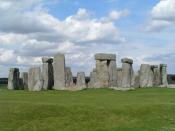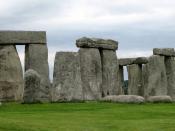Stanenges, where stones of wonderful size have been erected after the manner of doorways, so that doorway appears to have been raised upon doorway; and no one can conceive how much great stones have been so raised aloft, or why they were built there." These are the words of Henry of Huntingdon, the first words ever recorded in history pertaining to the marvel known as Stonehenge (Chippindale 20). The features, theories, and uses of this ancient marvel and wonder of he world are not only numerous, but also intriguing.
Stonehenge, a word with Saxon-origin meaning "hanging stones", is located on Salisbury Plain in mid-Wiltshire, England. Although it is composed of massive stones, it is still relatively small in diameter, measuring a meager 35 paces across, or about the size of the dome in St. Paul's Cathedral (Chippindale 10). Even though the possibilities are endless, it is believed to have been built by the Druids, Greeks, and the Phoenicians (5).
The first stage of Stonehenge took place from 3100 B.C. to 2300 B.C. During this span of 800 years, the groundwork for what would become one of the world's most fascinating monuments was laid. The ditch that surrounds Stonehenge was dug with antler picks, and the silt that was removed was piled into a bank that reached a height of 6 feet. A broad entrance way was also created on the Northeast side of the ditch (Chippindale 267). In addition to these features, 56 holes, later named the Aubrey Holes, were dug encircling the ditch. The holes differed greatly in depth and size (Souden 30). In the middle of this time, roughly from 2900 B.C. to 2400 B.C., it is believed that large timbers were erected. Many holes that are found inside of the ditch are suggestive to this...


